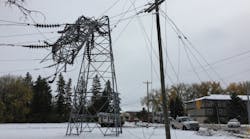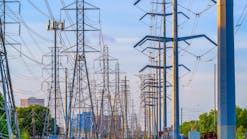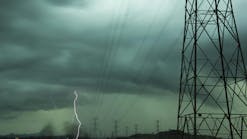Manitoba Hydro has completed its damage assessments of the transmission and distribution system after a recent storm left the province in a state of emergency.
In addition to multiple collapsed steel towers on the transmission system, more than 1000 wood poles were confirmed broken and in need of replacement in the Interlake, as of Oct. 14. Another 1000 broken poles needed replacement in the areas around Portage la Prairie.
Despite significant progress in restoring electrical service to customers across southern Manitoba, including Winnipeg, as of 10 a.m. Oct. 14, approximately 20,000 customers in the province were without power. This included many customers in the City of Portage la Prairie, a number of remote indigenous communities, and approximately 800 customers in the City of Winnipeg.
Damage assessment and preparation for significant restoration work continued with eventual access to previously inaccessible areas. Manitoba Hydro crews compiled lists of supplies and hardware needed to restore service and make permanent repairs. In some areas, rebuilds of entire parts of the electrical system were required. The utility used two helicopters to perform aerial line patrols to catalogue the damage to its T&D systems. Hardest hit areas included the regions around Portage la Prairie, Neepawa, Dauphin, Ashern, and Arborg.
In Winnipeg, work to restore power to the remaining customers in the hardest hit areas was impeded by the high number of down trees. Trees and large branches had to be removed before assessment and repair could begin. Crews had to work door-to-door bringing on individual customers.
“This is damage on a scale never before seen in Manitoba,” Jay Grewal, president and CEO of Manitoba Hydro, said after the storm. “And it doesn’t account for the additional damage we are likely to find once repairs begin. Our construction staff estimate that we may find almost another 1000 poles that are damaged and need replacement.”
To address widespread outages, a state of emergency was declared by the Province of Manitoba on Oct. 13, which allowed Manitoba Hydro to invoke mutual aid agreements in place with neighboring utilities who are now sending materials, equipment, and personnel to Manitoba to aid in the reconstruction and restoration efforts. This is the first time Manitoba Hydro has ever invoked a request for mutual aid from other utilities, which is an indication of the unprecedented level of damage done to the province’s electric grid.
“With the ground so wet from the rain and melting snow, we need specialized equipment in order to be able to access many areas where our lines are located,” said Grewal. “While Manitoba Hydro has a lot of this equipment already, the scale of damage means we need even more. And our neighbors have responded, for which we and our customers are extremely grateful.”
Saskatchewan Power Corporation sent five diggers, two bucket trucks, and one tracked crane, along with 21 staff to operate the equipment and assist Manitoba Hydro crews working in the Portage, Neepawa, and Dauphin areas.
Hydro One sent 25 powerline workers from northern Ontario to assist Manitoba Hydro crews in Arborg and other areas of the Interlake. The utility also provided several pieces of equipment including tracked diggers, bucket trucks, and service vehicles to aid in the storm restoration efforts.
Hydro One employees are trained to work in emergency situations on T&D systems. "Our thoughts and prayers are with those affected by this severe snow storm," said Darlene Bradley, acting chief operating officer, Hydro One. "Our highly skilled storm responders have a long history of restoring power during times of crisis. We are proud to share our resources to assist our neighbors during times of need."
From the south of the border, Minnesota Power provided tracked equipment and 14 staff to assist with restoration efforts in the areas around Portage la Prairie.
“So much of the damages in the hardest hit areas aren’t simple repairs,” added Grewal, after the storm. “We are talking about having to rebuild miles of distribution lines and rebuild sections of our transmission network, including enormous steel towers. The work will continue even after customers are restored, as we make temporary repairs to restore service as quick as possible before beginning work on permanent fixes. Make no mistake, this is a very serious situation.”
Manitoba Hydro reminded customers to never use portable fuel-burning equipment — generators, patio heaters, barbecues, or camp stoves — inside their homes for heating. Fuels from these create carbon monoxide (CO), a highly toxic gas that causes sickness and death.


